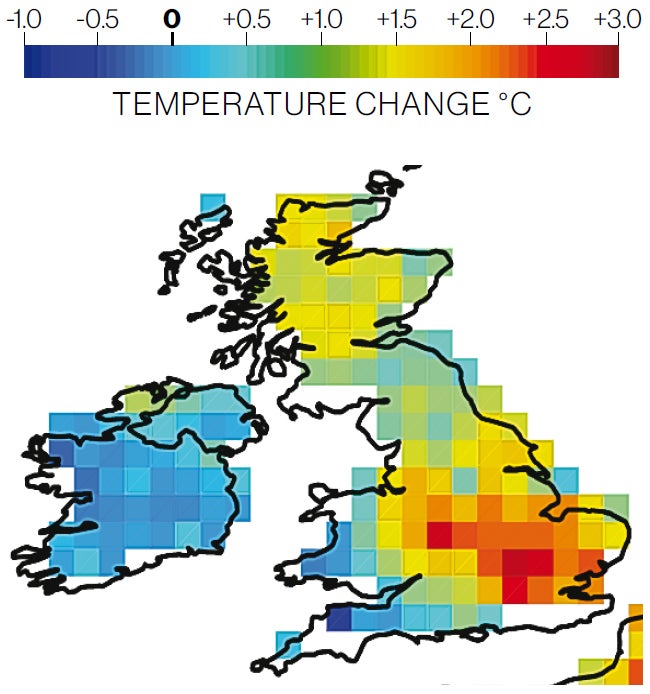Another sign of the growing North-South divide, but this time it's climate change
Detailed study shows inconsistent impact of climate change on weather across Europe

Global warming even applies to the North-South divide according to scientists who have discovered that temperatures in the south of the country have been rising much faster than in the north.
In the most extreme case of the temperature divide, a new paper finds that, since 1950, climate change has made the hottest days of the year rise by at least 2.5C in much of the south east, but just 1C or so in the north east.
Dr David Stainforth, the lead author on the paper, said: “In Britain, climate change will feel very different if you live in Northumbria than if you live in Oxfordshire; different again in Devon.”
He explained: “Climate is fundamentally the distributions of weather. As climate changes, the distributions change... But they don’t just shift, they change shape. How they change shape depends on where you are.”
The ‘changing shape’ of the climate is affecting the temperature in all sorts of unpredictable ways, according to the first detailed map of how climate change is influencing the weather in Europe, which paints an extremely inconsistent picture.
For example, while temperatures in the south of Britain are generally rising faster than in the north, there are cases where the thermometer increases are higher in the north. These include the coldest 5 per cent of nights, when temperatures have increased by at least 1.5C across much of the north east since 1950, compared to between 0.5C and 1.0C in the south.
When it comes to the hottest summer days, Wales has seen a smaller increase than the north – of between zero and 0.5C- since 1950.
Meanwhile, the coldest 5 per cent of summer daytime temperatures have hardly risen across Europe in the past six decades, according to the paper. By contrast, the mean global temperature – across all areas and times – has risen by 0.5C since 1950.
Apart from location, the temperature is much more influenced by factors such as the season and the time of the day than previously thought, although nobody yet knows why.
Professor Sandra Chapman, another author of the paper, said: “It is common to discuss climate change in terms of changes in global average temperatures but these can be far from people’s perceptions of climate change. The results in this paper begin to provide a picture of how local climate has been changing across Europe. It is a picture which is closer to that experienced by individuals.”
The research was conducted by the Grantham Institute and Warwick University and published in the journal Environmental Research Letters.
The paper’s findings were welcomed by climate change scientists, who said they cast valuable new light on the mechanics of global warming.
However, some were concerned that climate change sceptics might seize on some of the milder findings – such as the relatively small temperature increases seen on the coolest summer days – to bolster their case.
Dr Doug Parr, chief scientist at Greenpeace, said: “The impacts of climate change are going to be complex and nuanced. It is wrong to suggest we have a full understanding of them, but the overall picture is clear.”
“This research suggests that the really uncomfortable days are getting more uncomfortable,” he added.
Dr Stainforth said: “We need to design buildings so that they don’t overheat, decide which are the best crops to plant and even plan for variations in large scale productivity. These would all benefit from knowledge of how the climate distribution has changed at particular locations.”
The paper examined changing temperatures between 1950 and 2011 and does not attempt to predict whether the trends it discovers will continue.
“This isn’t telling us what will happen in the future. My gut feeling is that the trend will continue. We don’t have any knowledge that the pattern is going to change in the future, but it might, so I wouldn’t want to predict,” Dr Stainforth said.
Given how unpredictable climate change is proving to be, his reluctance to predict the future looks extremely wise.
Subscribe to Independent Premium to bookmark this article
Want to bookmark your favourite articles and stories to read or reference later? Start your Independent Premium subscription today.

Join our commenting forum
Join thought-provoking conversations, follow other Independent readers and see their replies